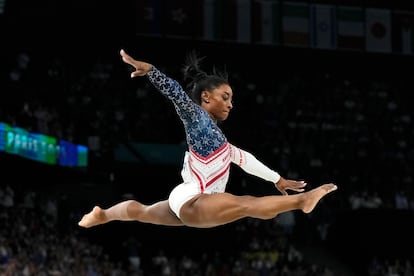
PARIS 2024
The resurrection of Simone Biles
The gymnast is once again the star of the U.S. team and of the Olympic Games. She is back and will end her journey in the world of sports only when she decides to
Paloma del Río31 July 2024
By now, everything has already been said about Simone Biles. That she was born into a broken home, that it was her grandfather who, with his second wife, adopted Simone and her sister Adria, and that she grew up happy and athletic doing gymnastics from the age of six. She joined the national team very early on due to her talent and began to stand out in “minor” competitions until she was old enough to be part of the U.S. senior team. The coach at the time, Martha Karoly (wife of Bela Karoly, coach and discoverer of Nadia Comaneci and Mary Lou Retton) included her in the national team for the 2014 World Championships in Antwerp, and at the age of 16 she was proclaimed world champion, a title she has won six times. She has won 30 medals at World Championships, of which 23 are gold, far surpassing the second gymnast with the most medals, Vitaly Sherbo, an Olympic champion in Barcelona 92. She was champion of the United States on nine occasions. And she arrived in Paris with seven Olympic medals, tied with Shannon Miller.
These are all numbers and statistics, but what makes Simone stand out is her human journey. Achieving sporting success means that you have the physical and mental conditions to submit to a level of stress above average, and to perform to a gymnastic level that is superior to that of others. And Biles has all of that.
After the 2016 Rio Games, with four golds and one silver under her belt, Simone decided to take a break from the sport and slow down her competition. Meanwhile, a scandal broke out at the United States Gymnastics Federation: a group of gymnasts denounced the abuse they had suffered for years at the hands of the team’s doctor, Larry Nassar. It was revealed that they had filed complaints and that both coaches, the Karoly couple, and federation leaders had ignored, if not silenced, these abuses. Two gymnasts first filed complaints and more than 260 ended up joining the cause.
During the court hearings, it became evident that the Federation had been aware of this behavior since at least 2015. And that it did nothing to stop it. Nor did it do anything to stop the abusive treatment that the Karolys doled out to the gymnasts in their training center, which had been converted into the national team’s gym.
In 2018, Nassar was convicted and the sum of the years he was sentenced to will keep him in prison for life. The Federation lost many sponsors for turning a blind eye to this behavior; the team of coaches who knew what was happening and did nothing was fired. The Federation began to renew itself with coaches who are morally involved in ensuring the sport remains free of sexual abuse and inappropriate behavior.
The brave gymnasts who stepped up were compensated. With all that baggage, Simone Biles showed up at the Tokyo Games, delayed a year by the Covid pandemic and held in exceptional circumstances: without an audience, without family members to support her. The athletes were all alone.
Her technical and gymnastic ability was fully demonstrated. A gymnast does not have five moves named after her in the Code of Points, gymnastics’ scoring system, if it is not due to their extreme difficulty. And in the women’s artistic gymnastics we find four Biles: two on vault and two on floor exercises: One of the latter, which she also used as an exit from the balance beam, is so difficult that the technical committee of the women’s artistic gymnastics asked her not to repeat it, but to “simplify” it to avoid accidents. Biles now does it with a double-twisting, single somersault instead of a double. A degree of difficulty that many male gymnasts do not dare attempt.
And then Biles exploded. She was the big favorite to win multiple gold medals, but at the team final she couldn’t do any more. In the vault rotation she simplified the somersault. “What’s going on here?” we thought. Immediately, we saw Simone talking to her coaches, we saw her get dressed and sit down to wait. And she didn’t compete again until the balance beam final.
Gymnasts are known for having aerospace control of their body during their somersaults and jumps. They know perfectly well where their body is in the air and where the ceiling and the floor are located. And Simone had lost that ability to track her position. It’s called the “twisties”: without body control, your balance suffers and falls and injuries can occur.
Biles immediately realized that the mind-body connection was not working and she took a break. There were many people who did not understand it. But she, her family, the world of gymnastics, did. And she made a very good decision: she put her own physical and mental health above Olympic glory.
After returning from Tokyo, she took a break to recover and did not return to gymnastics until 2023. Today, she is once again the star of the team and of the Games.
The team has already won gold, and she has qualified for the individual all-around final and and the finals for vault, balance beam and floor exercise. She can take home five more Olympic medals from Paris, adding to the seven she already had.
She has acquired a new move that bears her name and has once again been the center of attention at the Games. Simone Biles is back and will end her journey whenever she decides to. At this point, no one questions her decisions. She is, without a doubt, the greatest of all time.


No comments:
Post a Comment